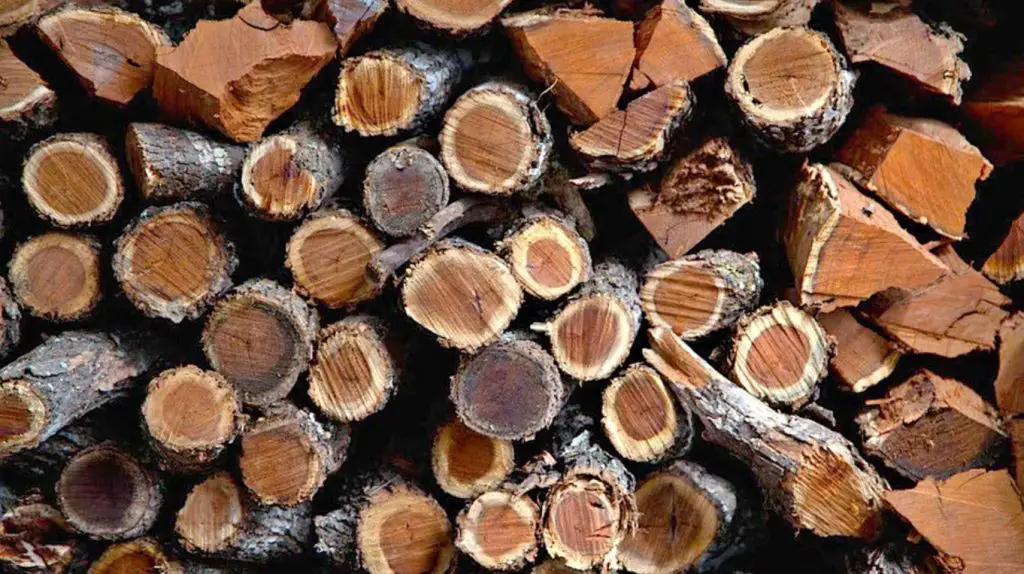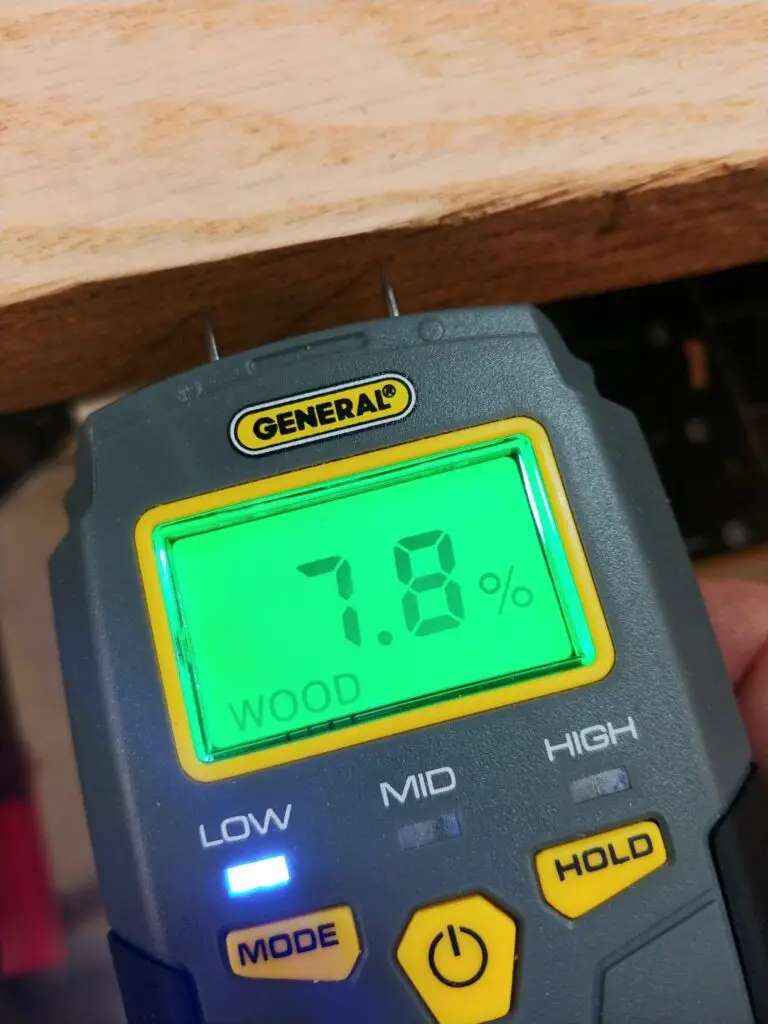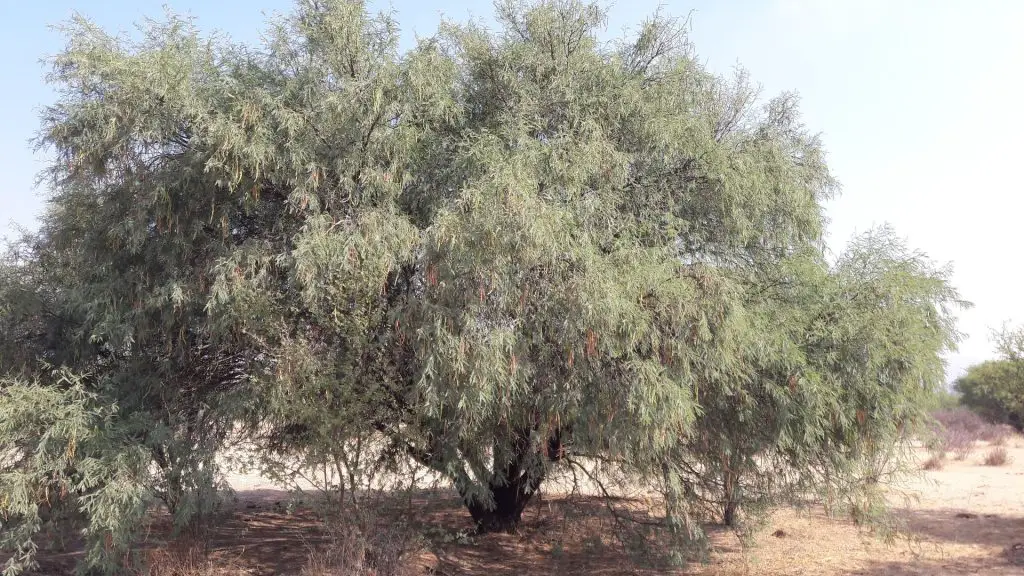Mesquite is excellent firewood that produces high heat production but does have a strong smoke smell that makes it better suited for smoking meat rather than heating your home.
Mesquite firewood is one of the most popular cooking and smoking meat options. But it isn’t as well suited for heating your home in winter. It has unusual characteristics for a hardwood because it has an extremely high heat production but seasons very quickly. It also produces a popular smell with a moderate smoke generation but can be difficult to split.
Mesquite is one of my favorite woods for burning outdoors, and I always have a supply available for cooking.
Table of Contents
Summary
- BTU: 28 million BTU/cord
- Weight: 4000 lb/cord green
- Seasoning Time: 6 months
- Splitting Difficulty: Moderate
- Sap Content: Low
- Smoke: Moderate
- Smell: Strong, Tangy
Mesquite is extremely popular firewood, primarily because of its smoky flavor and use in cooking. If you have ever had Texas barbeque, then you will be familiar with the smell of mesquite smoke. It also seasons extremely quickly for a hardwood within a year, making it easy to plan for winter.
However, it does have some downsides. It produces a moderate amount of heat which is great for cooking but can be too much for burning indoors. It also is only available in dry environments, so it doesn’t make it to the northern states. It can also be difficult to split because of the spindly branches that need to be removed.

Heat Production
Mesquite is one of the highest heat-producing firewood with 28 million BTU/cord. Compared to ash at 20 million BTU/cord, you need 25% less mesquite to produce the same amount of heat. This dense firewood also produces great slow-burning coals from its high-density wood. This combination of heat production and coals, along with its smokey smell, is great.
Mesquite produces so much heat that you will need to dial back the number of logs you put on your fire at once. A good idea is to split your firewood into smaller pieces so you can control the heat more closely.
Smoke Production
Mesquite is famous for its smoke production, in particular for smoking meat. I would rate it as moderately smokey, to the point where you might be reluctant to burn it indoors.
Seasoning Time
Another advantage of mesquite is that it seasons extremely quickly for hardwood. This is because it lives in dry environments and starts off very dry to begin with. It is also mostly stored and stacked in hot environments, which helps to season it quickly.
Mesquite seasons typically occur 6 to 9 months from start to finish, which is extremely useful in building a stockpile within a year. This gives it a key advantage over all other hardwood species with similar high heat production.
You can get some issues with mold and rot in mesquite, so keep it off the ground and away from moisture.
I personally recommend this General Tools Moisture Meter. It allows you to accurately gauge how wet your firewood is and whether it is sufficiently seasoned. Over time you can also see how quickly the moisture is dropping and how much longer you need to keep your firewood dropping until it is seasoned and ready to burn.
Press the sharp pins into the wood and you will quickly see the readout show the moisture ranging from 5% to 50%. It also has a Low/Mid/High indication depending on whether the wood is dry enough, so you don’t need to remember the actual values.

Burning Smell
Mesquite is one of the most popular firewood due to its smell. It is extremely popular for smoking meats and its use in barbeque. I would describe the smell as sweet/tangy and cannot distinguish it from the flavor of BBQ anymore. You can often buy mesquite chips from your local hardware store.
I would mesquite as one of the best smelling firewood, and it is right up there with pecan, apple, and maple.
Creosote Buildup
Creosote is a black soot that builds up in your chimney from unburnt wood. Over time, this can build up in quantity, combust, and cause chimney fires. Keeping your chimney clean is essential to reduce the risk of house fires and chimney damage. Creosote forms especially from green softwood that has a high sap content.
Mesquite is a dry hardwood and doesn’t produce a lot of creosote. I still recommend cleaning your chimney regularly, regardless of the wood you use, to eliminate this risk completely.
Splitting
The mesquite trunk is not particularly difficult to split but is difficult to process. This is because the trees grow in irregular directions with lots of spindly branches that need to be removed. If you are processing a mesquite tree into firewood then you will quickly become an expert in limbing branches off the main trunk.
The yield of a mesquite tree is low, so it will take several trees to produce each cord of mesquite firewood.
Some mesquite species also have thorns, making it even more difficult to split.
Different Types/Species
Mesquite trees are one of the most common trees found in Mexico, with over 40 different species within the genus. They are well suited to dry environments, which is why the wood seasons quickly. They are found in anything from a shrub to up to 50 feet in height. There are three most common species of mesquite: honey, velvet, and screwbean.
Honey Mesquite
The first species is honey mesquite, which grows in Northern Mexico and the Southern United States. It grows in hot, dry conditions and grows painful thorns. It grows seed pods that resemble wax beans due to their tubular appearance. Its bark is reddish, scaley, and rough to touch.
Velvet Mesquite
Velvet mesquite trees are the most common in South-west US, and grow natively in the Mojave desert. Their bark is almost black and can grow up to 25 feet tall. They can live up to 150 years old and have large root systems to pull moisture out of their dry environments.
Screwbean Mesquite
Also known as the American Screwbean, the Screwbean Mesquite is the last species we will be covering. It is a small shrub found along streams in deserts. It has thorns and grows a uniquely shaped screw-shaped bean.

Comparison to Other Woods
Here, I’ve taken some of the most popular firewoods to burn indoors and compared them to mesquite firewood.
The table below shows some of the key characteristics of mesquite firewood compared to alternative top-tier hardwood options.
| Firewood | Million BTU/Cord (source) | Ease of Splitting | Coals | Overall Quality |
| Green Ash | 20 | Easy | Good | Excellent |
| Maple | 25 | Easy | Excellent | Excellent |
| Bur Oak | 26 | Easy | Good | Excellent |
| Mesquite | 28 | Moderate | Good | Excellent |
Mesquite is an excellent firewood with high heat production and good coals for cooking. Its smell is famous for smoking meats, and it seasons extremely quickly for a hardwood. However, it is costly to buy and is difficult to process because of its short stature and spindly branches.
FAQs
Can you burn mesquite wood in a fire pit?
Yes, mesquite is extremely popular for outdoor cooking because of its higher smoke generation than other hardwoods. It burns hot and slow, producing stable coals well-suited for cooking. Mesquite is also popular for smoking meat in outdoor barbeques.
Can you burn mesquite wood in a wood stove?
Yes, mesquite produces a lot of heat and will heat your home all winter. It does produce a moderate amount of smoke which can be overpowering if you are sensitive to smells. I recommend installing glass screens and good ventilation to ensure the smoke doesn’t build up inside your home. In my opinion, there are better woods for indoor heating than mesquite, such as oak.
How much does mesquite firewood cost to buy?
Mesquite is one of the most expensive firewood to buy in the United States because of its popularity for smoking meats. It can only grow in dry locations, reducing its availability in the colder Northern States.
Final Thoughts
Mesquite is a top-tier firewood that justifies its high price tag. It is extremely dense and produces a lot of heat, but its moderately high smoke generation means it is only suitable for burning indoors in highly ventilated fireplaces. Its smell is delicious, and it is by far the most popular wood for smoking meat. Mesquite grows short and spindly, meaning that the yield of firewood per tree is low and takes a long time to process due to the quantity of limbing.
